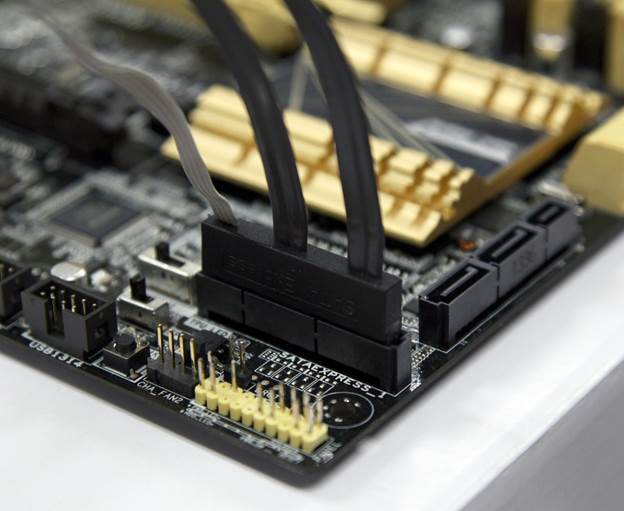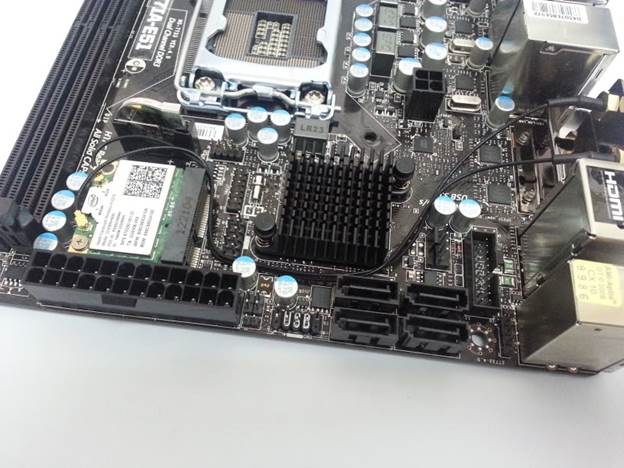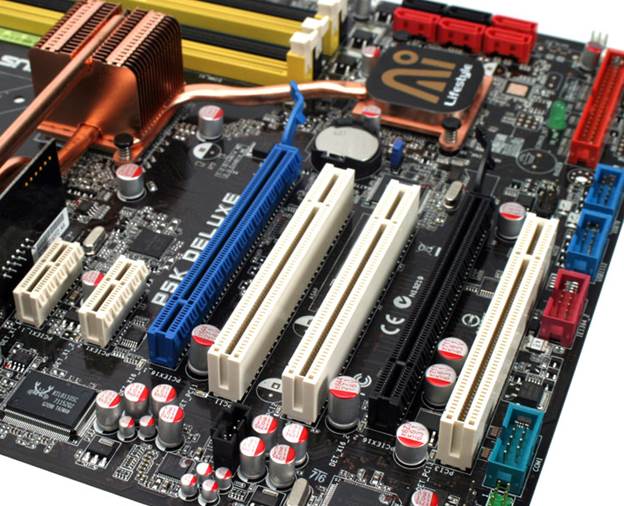All Aboard The SATA Express
On August 8 2013, the SATA-IO announced
that the SATA Express (or SATA 3.2) revision, which is a new revision that lets
the PCI-E bus double as a SATA interface, had been finalized. The SATA Express
connector will let users connect new SATA Express devices (most likely in the
form of SSDs), traditional SATA devices, and traditional PCI-E devices to a
supporting motherboard. In certain cases, adapters may be necessary. As we
mentioned above, a single PCI-E 3.0 lane has more than a leg up on SATA III,
but SATA Express can utilize up to two PCI-E lanes, which gives it peak data
rates of up to approximately 2GBps.

Next
Gen: ASUS Z87 Deluxe/SATA Express
Because there are two protocols involved,
the terminology used to refer to the new SATA Express devices and components
can get tricky. According to the SATA-IO, the SATA Express specification refers
to the host (currently a discrete IC separate from the chipset) and device connectors
that are capable of supporting SATA or PCI-E devices. SATA Express connectors
refer to the physical interface on the motherboard and on the device itself.
The SATA Express host refers to a system that has both the SATA Express host
connector and the logic to switch between PCI-E and SATA depending on the
device connected. The term “SATA Express PCI-E device” refers to a storage
devic e that features a SATA Express connector.

PCI-E
16X for you VGA or PCI-E devices. I/O outputs has DVI/D-Sub/DP
What will the SATA Express connector look
like? Depending on the type of hardware it will support, the SATA-IO proposes a
few different options. One of the proposed plugs features a uniform row of
contacts with notches to support PCI-E devices made for SATA Express. Another
supports a pair of standard SATA III cables, doubling as two discrete SATA III
ports. This latter design is the one ASUS opted to use on its SATA Express
prototype.
AHCI vs. NVMe
SATA Express PCI-E devices need a software
foundation that facilitates the exchange of data between them and the attached
host system memory. Traditional SATA-based storage devices use AHCI (Advanced
Host Controller Interface), which was supported in Microsoft’s operating
systems starting with Windows Vista. This technology enables device- level
support for hot plugging (lets the user plug and unplug a given component
without first shutting the system down) and Native Command Queuing, which means
different things for HDDs and SSDs.

All
SATA ports support Native Command Queuing (NCQ), hot plugging, ATAPI devices,
port multiplier with command-based switching supporting and programmable output
swing control to suit eSATA connections
In mechanical hard drives, NCQ refers to
the scheme whereby the drive can reorder the pending read/write commands to
better suite where the requested data is located on the platters. It takes
longer for the platter to make a single revolution than it does for the
actuator arm to skip across the surface of the platter, so NCQ lets the hard drive
queue up read and write commands based on a more latency-aware sequence. This
effectively decreases the number of revolutions necessary to perform the
commands. In SSDs, NCQ offsets host latency by queuing commands and using
pipelines to process commands concurrently. The benefit of a SATA Express PCI-E
device that relies on AHCI is that it retains compatibility with SATA software
environments and most major operating systems currently in use. The drawback,
however, is that AHCI was built with mechanical hard drives in mind, not SSDs.
As a result, AHCI can only handle 32 simultaneous commands.